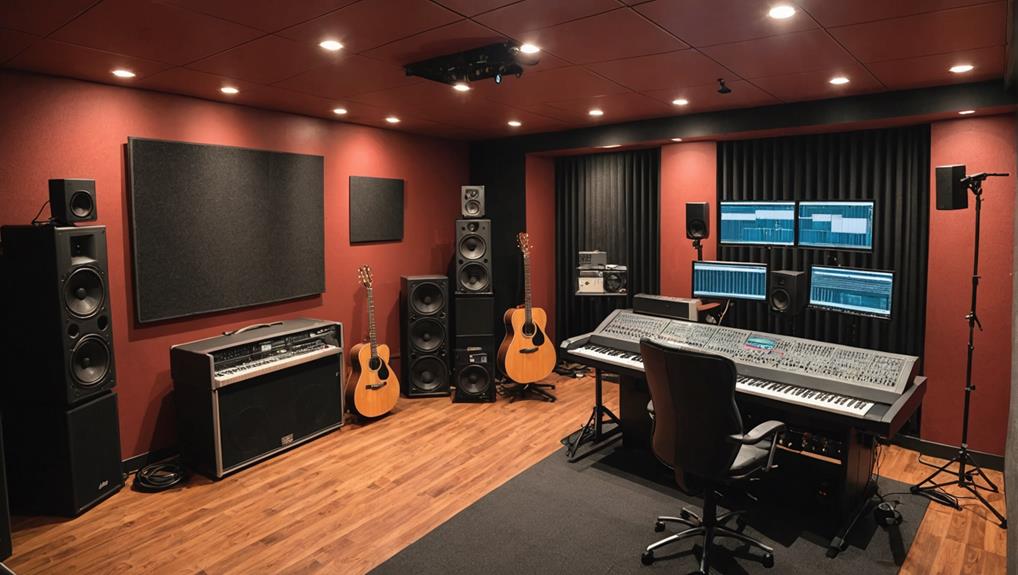Using the best acoustic treatment materials is essential for creating a space where sound quality shines. You’ll reduce unwanted noise and echoes, making speech clearer and more intelligible. High-quality materials not only enhance productivity but also contribute to your overall well-being by lowering stress levels. By targeting specific frequency ranges, you can achieve a balanced sound in any environment. Plus, premium materials last longer, saving you money on replacements down the line. If you’re curious about which materials suit your needs best and how to use them effectively, there’s plenty more to discover.
Key Takeaways
- High-quality acoustic materials significantly improve sound clarity, reducing unwanted echoes and enhancing speech intelligibility.
- Premium materials lower ambient noise levels by 10-20 decibels, creating a more productive environment.
- Durable construction ensures long-term cost savings, reducing the need for frequent replacements.
- Fire-resistant properties enhance safety in various settings, protecting occupants and property.
Importance of Acoustic Treatment
Acoustic treatment is essential because it helps you reduce unwanted noise and echoes, making your space sound clearer and more inviting. By effectively absorbing sound waves, acoustic treatment materials considerably lower noise levels, enhancing the overall sound experience. This improvement can be particularly beneficial in crowded environments, like restaurants and offices, where clear communication is vital.
One of the key benefits of acoustic panels is their ability to lower reverberation time by up to 50%. This reduction means you’ll enjoy better speech intelligibility, allowing conversations to flow more naturally. High-quality materials, such as dense mineral wool or fiberglass, can create a more comfortable atmosphere, promoting productivity and reducing stress for everyone in the space.
Moreover, specialized acoustic treatments like bass traps and diffusers help you address specific frequency ranges, ensuring a balanced sound profile tailored to your needs. Investing in professional-grade acoustic treatment not only meets regulatory noise control standards but also contributes to the long-term health and well-being of occupants.
Key Acoustic Concepts Explained
Understanding key acoustic concepts is essential for effectively improving sound quality in your space. Sound waves interact with surfaces, leading to various phenomena that can impact your audio experience.
| Concept | Description | Impact on Sound Quality |
|---|---|---|
| Reflection | When sound waves hit hard surfaces, they bounce back. | Creates muddiness and unclear audio. |
| Reverberation | Persistence of sound due to multiple reflections. | Causes echo effects, complicating speech intelligibility. |
| Resonance | Amplification of certain frequencies from vibrations. | Distorts sound if not controlled. |
To manage these issues, you’ll need effective acoustic treatment materials. These materials absorb sound, specifically targeting reflections and controlling reverberation time. By using the right treatments, you can minimize unwanted resonance, allowing for clearer and more enjoyable sound experiences. Remember, the choice of materials matters: denser options excel at absorbing lower frequencies while lighter materials are better for higher frequencies. This tailored approach guarantees you achieve peak sound quality, making every moment in your space more immersive and enjoyable.
Types of Acoustic Treatment Materials
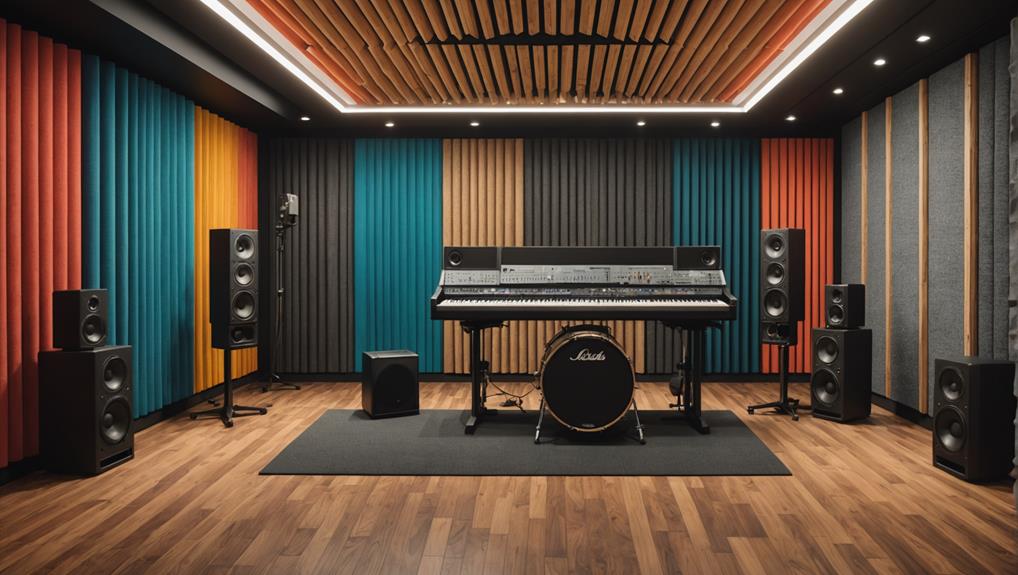
Numerous types of treatment materials can greatly enhance sound quality in your space, each tailored to address specific acoustic challenges.
Foam panels are a lightweight and affordable option that effectively absorbs high-frequency sounds, making them ideal for home studios or small rooms. If you’re looking for something more robust, fiberglass panels excel in absorbing mid-to-high frequency sounds and are often found in professional recording studios due to their dense, fire-resistant properties.
For low-to-mid frequency absorption, rockwool panels are a fantastic choice; they also provide insulation and fire resistance, making them suitable for both commercial and residential applications. If aesthetics matter, consider fabric-wrapped panels. These not only absorb sound reflections but can be customized in color and design to fit your space.
Lastly, don’t overlook bass traps. Typically thicker than standard acoustic panels, bass traps are specifically designed to target low-frequency sounds, reducing muddiness and enhancing clarity in larger spaces.
Benefits of Investing in Quality
Investing in high-quality acoustic treatment materials greatly enhances sound clarity and reduces echo, making your space more enjoyable and functional. When you choose premium materials like dense fiberglass or rock wool, you considerably improve sound absorption efficiency, which is vital for environments such as recording studios and concert halls. These materials excel in low-frequency absorption, elevating the overall sound quality you experience.
Quality acoustic panels often boast durable construction, ensuring they maintain effectiveness over time. This durability means you won’t need frequent replacements, ultimately saving you money in the long run. Plus, higher-grade materials usually come with fire-resistant properties, making them a safe choice for various settings, including commercial spaces and public venues.
Another benefit of investing in quality is the aesthetic customization options available with premium acoustic solutions. You can blend these panels with your interior design while still achieving ideal acoustic performance.
In short, investing in top-tier acoustic treatment materials not only enhances your auditory experience but also adds value and safety to your environment. It’s a smart move for anyone serious about sound quality.
Choosing the Right Materials
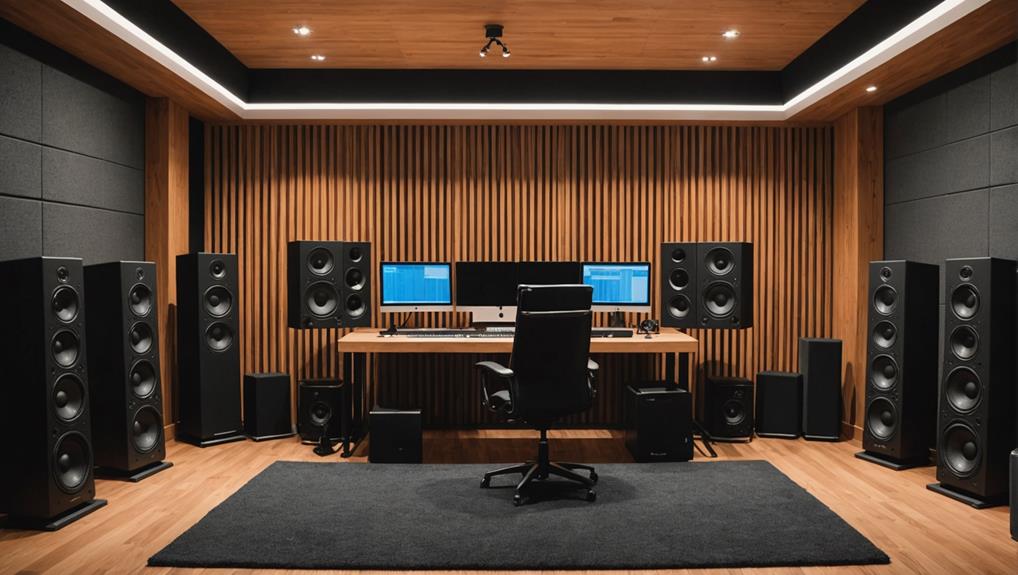
Choosing the right materials for acoustic treatment can greatly enhance sound quality in your space, ensuring you get the most out of your investment in high-quality solutions. When it comes to selecting the best options, consider the following:
- Acoustic Panels: Opt for panels made from fiberglass or rockwool. These materials excel in absorbing mid to low frequencies, which is essential for environments like recording studios where clarity is critical.
- Absorbing Material: Look for dense, soft materials such as mineral wool or thick foam. These types of acoustic treatments effectively absorb sound waves, considerably improving overall sound quality.
- Thickness Matters: The thickness of acoustic panels plays an important role in their absorption capacity. Thicker panels generally manage sound better across a wider frequency range, giving you a more balanced acoustic environment.
Common Acoustic Challenges
You might find that common acoustic challenges, like excessive echo and reverberation, can greatly impact the quality of sound in your space. These issues often arise in rooms with hard surfaces that reflect sound waves, leading to confusion during conversations.
Excessive reverberation means sound waves accumulate, making it tough to discern speech and increasing ambient noise levels.
Another challenge is noise bleeding between rooms, which can disrupt communication, especially in open office environments or shared living areas. Low-frequency sounds, often referred to as bass, can muddy audio quality, making it necessary to use bass traps for effectively absorbing sound and improving clarity.
Inadequate acoustic treatment can contribute to heightened stress levels, as struggling to concentrate in noisy environments can be draining. By addressing these common challenges with solutions like acoustic panels, you can enhance sound quality and create a more comfortable atmosphere.
Not only will this help in reducing stress, but it’ll also foster better communication and productivity. Taking action against these acoustic challenges is essential for transforming your space into a harmonious environment.
Installation Techniques for Effectiveness
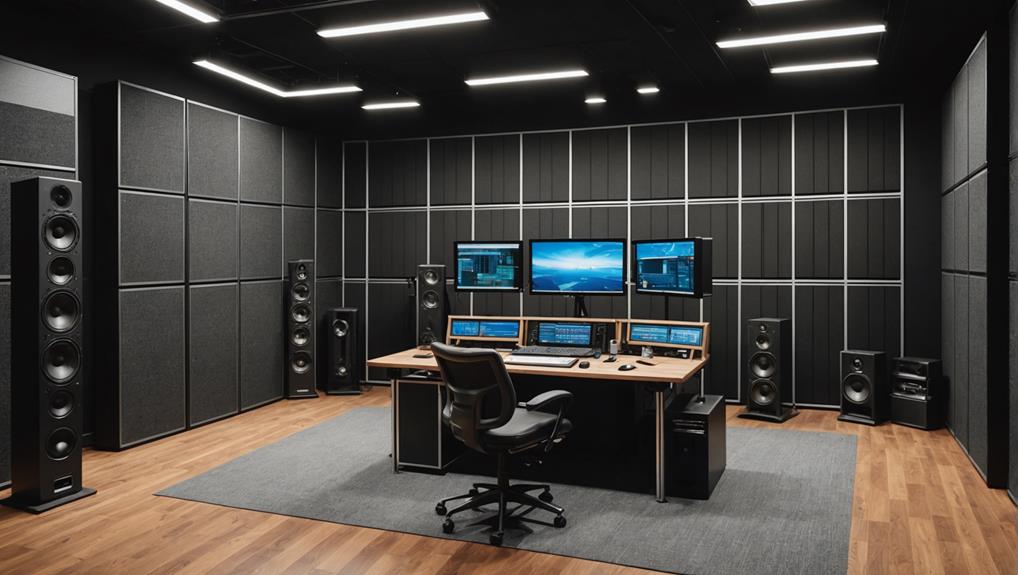
Effective installation techniques are essential for maximizing the performance of acoustic treatment materials in any space. If you want to achieve ideal sound absorption and reduce unwanted sound reflections, you need to focus on the right placement and secure mounting of your acoustic panels and bass traps.
Here are three key installation techniques to take into account:
- Height and Angle: Mount your acoustic panels at ear level and angle them toward sound sources. This reduces reflections and enhances sound absorption.
- Strategic Placement: Position bass traps in the corners of the room where low-frequency sound waves tend to accumulate. For acoustic panels, place them directly opposite sound sources and in areas where reflections are most problematic.
- Secure Mounting: Use appropriate adhesive or mechanical fasteners based on the weight and type of your acoustic panels. This guarantees they remain securely in place over time, maximizing their effectiveness.
Customization Options Available
Custom acoustic treatment options offer a range of shapes, sizes, and colors that can effortlessly blend with your existing decor while enhancing sound management. You can choose custom acoustic panels designed to fit your unique aesthetic while effectively managing sound. Fabric-wrapped panels allow you to select from various textile options, enhancing the visual appeal of your space without sacrificing acoustic benefits.
With customizable acoustic solutions, you can address specific needs, such as integrating bass traps in corners or installing diffusers on walls and ceilings. This guarantees ideal sound distribution tailored to your environment. Furthermore, manufacturers often provide the opportunity to create custom artwork or graphics on acoustic panels, allowing you to express your personal style while maintaining essential sound absorption properties.
When it comes to tailored acoustic treatments, consider the unique challenges of your space, such as ceiling height, room dimensions, and intended usage. By customizing your acoustic solutions, you can achieve an effective balance between aesthetic appeal and functional sound management, transforming your area into a harmonious environment that meets your specific acoustic needs.
Professional Vs. DIY Solutions
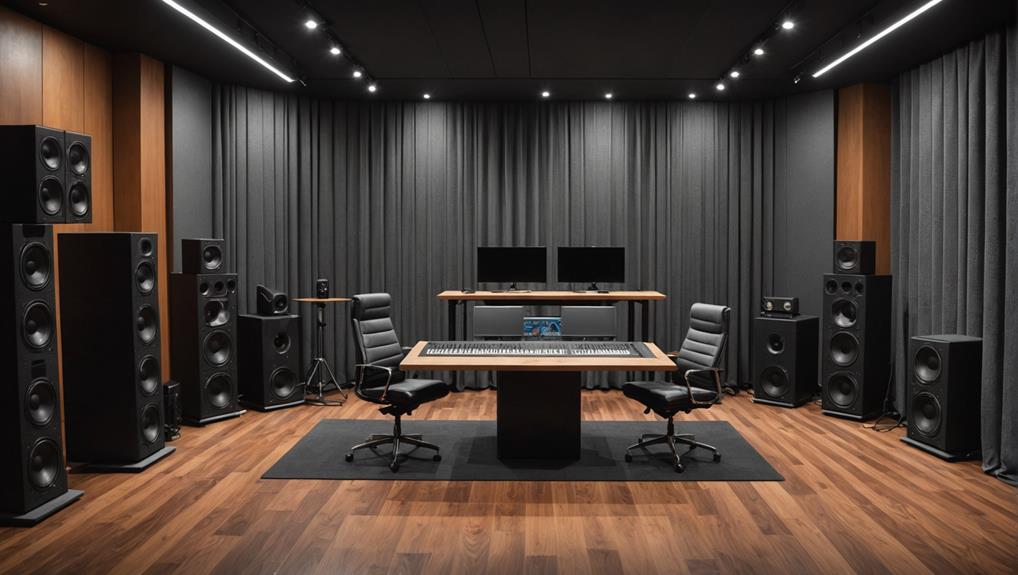
Balancing aesthetic appeal with sound management often leads individuals to weigh the benefits of professional acoustic treatment solutions against DIY options.
While DIY solutions might save you some cash, they often fall short in acoustic quality compared to professional solutions. Here are three key differences to evaluate:
- Material Quality: Professional solutions use higher density materials engineered for superior sound absorbing capabilities, ensuring better performance across all frequencies. In contrast, DIY materials like foam may not effectively address specific acoustic challenges.
- Expert Installation: Professionals design and install treatments tailored to your space, utilizing strategic panel placements. DIY efforts often rely on generic layouts that miss the nuances of your room’s sound profile.
- Long-term Benefits: Investing in professional services can yield lasting improvements in sound clarity and overall environment quality, making it worthwhile for serious audio applications. While DIY solutions may offer a quick fix, they might require frequent adjustments to maintain satisfactory results.
Ultimately, evaluating these factors will guide you in choosing the best approach for achieving superior acoustic quality in your space.
Long-term Impact on Sound Quality
High-quality acoustic treatment materials can dramatically improve sound quality over time, guaranteeing a more enjoyable auditory experience in your space. When you invest in premium materials like dense fiberglass or mineral wool, you enhance sound absorption capabilities, reducing echoes and reverberation considerably. This leads to clearer audio across a broader range of frequencies.
Here’s a quick comparison of the benefits of different acoustic treatment materials:
| Material Type | Benefits |
|---|---|
| Premium Materials | Superior sound absorption, longevity, durability |
| Standard Materials | Limited sound absorption, shorter lifespan |
| DIY Solutions | Variable effectiveness, potential quality issues |
Utilizing high-grade acoustic panels can decrease ambient noise levels by 10-20 decibels, creating a more comfortable environment. Additionally, the longevity of these materials means you’ll enjoy sustained sound quality improvements for over a decade. In contrast, lower-quality options may degrade over time, compromising their sound absorption capabilities. Investing in the best acoustic treatment materials not only enhances your space today but guarantees it remains an auditory haven for years to come.

